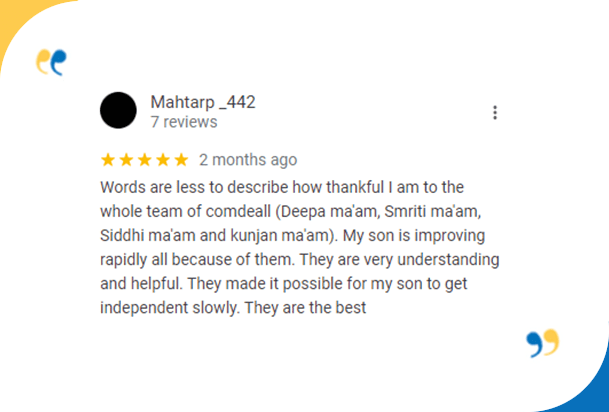

The most popular questions asked
The Early Intervention Program is focused on the holistic growth and development of a child with the help of specialists and experts. This program is targeted toward infants and toddlers to help them optimise their potential. Early Intervention Programs are very empowering for children as well as their families.
The benefits of treatment at Communiverse:
- Our team provides all the services you need under one roof
- We use therapies explicitly designed for children, teens and young adults
- We partner with you to make the best treatment decisions for your child
- We connect with children and motivate them to work with us
We cater to a diverse population of children who present with developmental needs such as
- Speech & Language Delay
- Other Developmental Differences that might show up in the Preschool
- Autism
- Global Development Delay
- Cerebral Palsy
- ADHD
- Down Syndrome
- Other Neurological & Syndromic Conditions
Makaton Signs & Symbols
The decision to use signs/picture symbols for your child will depend upon your child’s profile. Makaton is a language program offering a structured, multimodal approach to teaching Communication & Language Skills. This was developed in the UK but an Indian version of the same is available. Children can, therefore, use specific signs to indicate their needs.
Picture Exchange Communication System (PECS)
Here, children use small pictures or symbols of commonly used words to request desired items or communicate basic concepts non-verbally. As mentioned earlier, it is important to introduce communication as early as possible. This helps the child understand the power of communication and that they can use words to be understood. Further, using pictures also helps children who face difficulties to initiate communication.
Mobiles & Tablets
Advances in mobile and tablet technology have revolutionized Alternate Augmentative Communication (AAC) usage. Children with Autism respond well to these devices and, with the right guidance, they can be powerful mediums for communication and learning.
Avaz (has Indian vocabulary) http://www.avazapp.com/
Proloquo2go (an advanced version that can grow with your child) https://itunes.apple.com/us/app/proloquo2go-symbol-based-aac/id308368164?mt=8
Speech Therapy is something that goes beyond the classroom. There are little things that parents can inculcate in their interactions with the child to help improve their communication skills.
Speak slowly and in a gentle manner
Children with Autism may take a little longer to process information than their peers. This is why it is important to be patient and gentle when communicating with them. Visuals or gestures also help enhance their understanding skills. For example, showing them pictures of places and activities they come across on a daily basis or pointing & pantomiming your actions as you speak is a good practice.
What does not help AT ALL is raising your voice or shouting at your child when they don’t follow your instructions. It is important to take them by their hand and guide them, without losing your patience.
To know more about the American Speech & Hearing Association’s (ASHA) statement of the best practices click here and then click on ‘Treatment’.
Have fun with your child
Parents often get so lost in overthinking the best approach or care for their child that they lose sight of the fact that at the end of the day, they’re still working with a kid who just wants to enjoy and experience life to the fullest. Find activities that your child finds joy in, like soap bubbles, tickle-tickle, fooling around with shaving foam, playing games like akkad bakkad bambe bo. It is important to set aside some time for fun and enjoyment without an end goal.
Gradually, as the child begins to anticipate these, they will wait for these interactions. This may be a good opportunity to teach the child the gesture for “come play”. Work with your therapist to build up communication once the child is interested in being with you. Words like “more”, “give me”, “yes/no”, “do not want” are easy to simulate during play.
At Communiverse, we create an environment that facilitates Language Development. The Speech Therapist is trained to elicit, not demand, speech. You will not find our therapist teaching your child a long list of fruits and vegetables even before they can communicate their basic needs.
Build upon what’s already there
If your child is able to make some sounds already, no matter how random or meaningless they might seem, you can use those sounds to develop their Proto Vocabulary. This is a technique we often use at Communiverse. Try to assign meanings to the sounds your child is making so that they gradually understand and begin to use these sounds more consistently. This might become a stepping stone in your child eventually moving towards real words.
Encourage them to mirror
A child will usually mirror or imitate what they see around them. So, it’s important for you to encourage them to do the same. The more times you facilitate sound production, the greater the strengthening of the neural networks required to produce the sounds.
For Com DEALL’s Protovocabulary booklet and other therapy aids to build communication click here.
Try not to underestimate them
Children understand much more than parents give them credit for. It is a common mistake to assume that a child who does not speak does not understand too. Speak to your child as you would with any other child of that age. It is very important that a child with a language disorder is provided a language-rich environment. Speak to your child about what they are seeing, doing, about their feelings. It will help share your thoughts. Parallel Talk is a powerful technique all therapists use. We train parents to Parallel Talk as well. This involves speaking on your child’s behalf. Many parents of children with Autism at our centre have used it with fantastic results.
For the manual on Parallel Talk click here.
Don’t impose yourself
No matter how happy or unhappy you are with the pace of your child’s progress, it’s important to let them bloom at their pace. Never force your child to speak or rush them in any manner whatsoever as you will run the risk of losing the gains made in therapy.
Explore AAC with your therapist. Children who cannot speak can be taught to point at pictures to indicate their needs; for example, pictures of food, toilet, water, etc. Some children pick up gestures to indicate these needs. It is important to develop these skills. Not being able to indicate even these basic needs can make a child very restless and frustrated. This may even lead to much negative behaviour, such as kicking, throwing things, biting, etc.
Many parents are scared to introduce AAC. They fear that their child will get too dependent on these alternate systems and will not try to speak at all. Nothing could be further from the truth. There is a lot of research that suggests that using alternate communication systems promotes Speech & Language Development. This has been our clinical experience at Communiverse as well.
We are different! We follow a developmental approach. This means that we assess the child to identify gaps and strengths in their development. We work towards bridging the gaps and often use strengths while doing so. For example, when a child is visually strong, we may use visual supports to develop their communication; or if a child has difficulty with motor imitation, our Occupational Therapist and Speech Therapist would work on these skills. We do not follow behavioural approaches. We follow the principles of language, motor and cognitive development and create an environment where the child experiences success at each level as we work with them towards bridging the gaps in development.
No. Depending on their needs, children receive intervention therapy and support for varying lengths. Some require it for a shorter period to overcome temporary developmental delays, whereas others may require follow-up special education or additional support & resources upon entering school.
Having a different timeline for developmental milestones is not concerning as each child grows at a different rate. For example, some babies might start walking or talking sooner than others. If you have a doubt, we recommend getting an assessment done so that you can get professional advice on whether you can wait or start intervention right away. Our team can empower you with strategies to stimulate your child’s development.
As parents, you know your child best so far and it’s important to lay all cards on the table for us to understand the case better. Parents play a pivotal role in their child’s assessment procedure. The following information can be shared by the parents:
- Medical records or priorly done evaluations
- Any questions or concerns they might have about their child’s development
- Videos of your child taken at home
We can provide intervention for children as young as 6 months.
Yes. As we rely on the Com DEALL Developmental Checklists to understand your child and plan intervention. We will look at the previous assessments to understand recommendations made by other professionals. If your child has been assessed by another Com DEALL affiliate unit (within the past six months), we will not reassess.
Many such issues are related to difficulties in the use of language (pragmatics), which has more recently been labelled Social Communication Disorder. This is an area we are particularly equipped to address, having done a lot of work on the ground. We would be happy to assist your child as well. To know more, click here.
We recommend a combination of both.
Initially, we work in individual sessions so that we establish a rapport with your child to build an empowering environment. These individual sessions are conducted till the child settles into therapy. Then, we work to quickly move the child into a group setting.
Skills such as turn-taking, paying attention even when the teacher’s direct focus is not on the child, shifting eye gaze, listening & learning in a group, participating & engaging in conversations with peers, playing rule-bound games and understanding hidden meanings in discussions are best learnt in a group context. Children also need to manage noise levels, tactile sensitivities and other sensory needs in group settings. Additionally, the nature of the condition itself is such that many children learn better when there is no direct expectation to perform. An expectation to perform often generates a lot of anxiety in the child and their ability to learn is reduced.
The length of therapy depends on the diagnosis as well as the severity of a child’s symptoms. We evaluate the level of care a child needs during the initial evaluation, and then we adjust the level of care according to the child’s needs throughout the treatment process. Our goal is to get your child out of therapy and back to school & friends as quickly as possible.
We recommend that children join regular schools when the gaps in their profile are not more than 9 months across developmental domains. Enrolling your child in school before your child is ready and equipped to handle classroom demands could result in setbacks/regressions. We run the risk of losing out on hard-earned gains in therapy if children are enrolled before they are ready.
We create treatment teams and work with families to address all of a child’s mental health needs. We will liaison with other professionals who may need to get involved (over and above our core team).
We look forward to offering our services to all children. Children who cannot be accommodated in the mainstream batch are helped in smaller batches of 6-7 children where we work on communication, activities of daily life and related skills required for more independent living, or in individual therapy depending on the needs of the child and their family.
Our experience over the past 20 years working with young children shows us that children are able to handle the hours. Sometimes when the child is less than 2.6 years, we may reduce the intensity of the intervention.
YES! We are committed to parent empowerment every step of the way. Parents are expected to come in, observe and learn how therapists provide intervention and support their child. In the initial stages, you can expect to come in more often; we want your child to feel comfortable with us. We will wean you out gradually, once trust and rapport are established. However, be prepared to be called in at frequent intervals for regular updates. You may also be required to work with your child in the therapists’ presence. This helps us to empower you and ensure that the transfer of skills to home is happening correctly.
That is the parents’ choice. For our part, our team would like you to come in at least once every fortnight. In some cases, where more handholding is indicated, we may request more frequent interactions.
In addition to involving the parents in the therapy rooms, monthly goals and progress reports are shared with each family. Our Parent Coordinator will connect with you to help carry forward the therapy into your home, helping you with specific activities. She will also help with scheduling language simulation techniques for home, making visuals, etc. We conduct Parent Training Webinars at regular intervals. Parents are encouraged to attend the same.
We work on a self-sufficiency model. This means that the fees collected from families are used to cover all our working costs. We are not out to make profits. However, our fees are reasonably high so that we can cover costs. We do offer concessions to a few families. Sometimes, families of children who have benefitted from our program come forward to help others. We utilise these to support families in need. Do let us know; if possible, we will provide some support.
Further, our online support models may be more affordable than our regular in-person therapy services.
Parent involvement and participation is integral to our process. We require parents to commit to the same. If you are unable to for any reason, our program will not benefit you.
Testimonials






